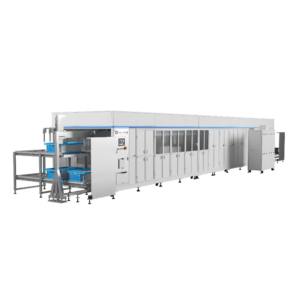Lithium-ion batteries have become essential components in energy storage across numerous industries, from automotive to consumer electronics. Their reliability and performance directly impact the products they power, making quality control a priority in battery manufacturing.
It is important to test lithium-ion batteries comprehensively for battery manufacturers under this circumstance so as to ensure that each battery meets safety performance and regulatory standards, test lithium-ion battery.
So, in this article, we’ll explore how to test a lithium-ion battery before delivery, covering key procedures and standards that support reliable battery performance.
(Copyright Photo from: https://www.freepik.com/free-photo/close-up-hands-holding-battery-cells_3149460.htm#fromView=image_search_similar&page=2&position=23&uuid=1c14f65c-51bc-494f-ac99-85cd67b4885b)
Essential Standards and Regulations to Test a Lithium-ion Battery
International Standards
Standards like IEC, UL, and UN 38.3 outline essential safety and performance guidelines to test lithium-ion batteries. IEC and UL focus on electrical safety and overheating risks, while UN 38.3 ensures batteries can withstand transport stresses, from environmental changes to mechanical impact.
Industry-Specific Standards
For the battery demand in sectors like automotive, additional standards like ISO 12405 are crucial for testing lithium battery systems. ISO 12405 evaluates cycle life, performance, and resilience, helping ensure automotive batteries meet high durability and safety requirements.
Regional Regulations
Regional regulations, such as those in the EU, add layers of safety and environmental compliance in battery cell manufacturing. These rules govern storage, handling, and disposal, ensuring batteries meet regional market standards.
For example, the EU Battery Regulation (Regulation 2023/1542) establishes a robust framework that addresses various aspects of battery production, use, and disposal. This regulation replaces the previous Battery Directive 2006/66/EC and introduces stringent requirements aimed at improving sustainability and safety throughout the battery lifecycle. Under this bill, testing a Lithium-ion battery should focus and consider more on carbon footprint, recycled content, restriction of substance, etc., to meet the new demands in modern society.
Core Procedures and Protocols for Battery Testing
From those vital standards and regulations above, effective testing on the battery production line requires a structured process to verify safety, performance, and durability. Here’s how to test a lithium-ion battery using core procedures and protocols:
Sample Selection and Preparation
Proper sample selection ensures accurate testing results. By using random sampling methods, you can identify issues on product quality early and ensure that the final product meets the standards of safety and performance. Consistent sample preparation is key to reliable testing outcomes.
Essential Battery Tests
Lithium-ion battery testing involves several important tests:
- Electrical performance tests assess voltage, current, and power output.
- Safety evaluations check for issues like short-circuiting, overcharging, and thermal stability.
- Environmental resistance tests ensure the battery can perform under extreme conditions, such as high or low temperatures and humidity.
These tests guarantee that the battery meets industry standards for both safety and functionality.
Contingency Planning
Unexpected issues can arise during testing. Having a contingency plan ensures a quick response to equipment malfunctions or test failures. This could include backup testing equipment or alternative protocols. Proper planning minimizes delays and ensures the integrity of the testing process.
Data Analysis and Reporting
Once testing is completed, the data is analyzed to determine if the battery meets performance and safety standards. Any failures are reviewed to understand their cause. A comprehensive report is then created, outlining the test results, any issues, and recommendations for improvement, which helps ensure quality control and customer confidence.
Quality Assurance in Delivery
Before shipping, each battery undergoes a final review to ensure it passes all necessary tests. Only batteries that meet the required performance, safety, and compliance standards are cleared for delivery. This final quality check ensures that customers receive reliable, safe, and high-quality products.
Benefits of a Turnkey Manufacturing Solution for Testing Lithium-ion Batteries
Having established a thorough understanding of the core procedures and protocols essential for effective battery testing, it is clear that precision and reliability are paramount in this field. However, to further enhance efficiency and ensure seamless integration of these testing processes, turnkey manufacturing solutions offer key advantages to test the lithium-ion batteries:
- Streamlined Testing: Turnkey systems automate testing, simplifying how to test lithium-ion batteries on the production line
- Improved Production: Automation speeds up testing, increasing throughput in high-demand environments
- Make Less Mistakes: Automation reduces human error as testing the Lithium-ion battery, ensuring consistent results.
- Seamless Integration: Testing is built into the lithium battery assembly line, ensuring thorough checks before delivery
- Adaptability: Manufacturers can adjust protocols to meet specific customer or industry needs
- Faster Time to Market: Streamlined processes speed up delivery without sacrificing quality
SZJ Automation’s Cylindrical Cell Turnkey Solution
SZJ Automation’s Cylindrical Cell Turnkey Solution can enhance efficiency, quality, and ease of use. It streamlines every phase of the lithium battery assembly line, combining advanced equipment with automated processes from raw materials to final battery pack assembly.
The fully integrated production line provides seamless control over manufacturing and testing. By optimizing assembly, testing, and packaging, SZJ Automation ensures high-quality output while reducing production time and errors. It can simplify how to test lithium-ion batteries and guarantee that they meet industry standards before delivery.
Conclusion
Rigorous testing on lithium batteries before delivery ensures safety, reliability, and performance. Knowing how to test lithium-ion battery components, from electrical checks to environmental resistance, is crucial to meeting industry standards and client expectations in the changing market demands. And the efficient approach to ensure the battery testing is applying the turnkey solution in the battery manufacturing factory.
Turnkey solutions from SZJ Automation can streamline this process, ensuring consistent quality and efficient production. And our expertise in intelligent manufacturing and turnkey solutions for cylindrical cells supports a smooth transition from raw materials to finished products. Contact us today to understand the well-equipped machines for manufacturing and testing lithium-ion batteries.





